Research on the Flow Characteristics of Power-Law Fluids in Self-Priming Sewage Pumps
Abstract
1. Introduction
2. Establishment of the Constitutive Equation for Power-Law Fluids
3. Numerical Computation Methods and Settings for Sewage Pumps
3.1. Fluid Domain and Mesh
3.2. Boundary Condition Settings
3.3. Numerical Computation Method Validation
4. Results Analysis
4.1. Velocity Analysis
4.2. Pressure Analysis
4.3. Vortex Structure and Vorticity Analysis
4.4. Wall Shear Stress Analysis
4.5. Analysis of Pressure Pulsations on Sewage Pump Blades and Baffle Plates
5. Conclusions
- Comparing the influence of different concentrations of CMC solution on the sewage pump, it was found that there is minimal difference in the velocity distribution.
- The vortices in the pump are mainly concentrated at the impeller inlet. This is because of the higher flow velocity at the impeller inlet, where power-law fluids experience greater shear forces, leading to a decrease in viscosity. With lower viscosity, the fluid is more prone to shear deformation and vortex motion. With the increase in concentration of CMC solution and the consequent increase in fluid viscosity, the vortices at the impeller inlet increase to some extent. Additionally, at a certain concentration of CMC solution, a small number of vortices are also generated in the volute region. As the concentration of CMC solution in the test pump increases, the strength of vortices at the outer edge of the impeller slightly increases.
- Analysis of wall shear stress revealed that the regions of high shear stress on the volute casing are located on both sides of the volute outlet, and they tend to slightly increase with the increase in concentration of CMC solution.
- The pressures on the impeller blades, within the flow passages, and at the tongue of the volute decrease with the increase in concentration of CMC solution. When the concentration of CMC solution increases from 0.5% to 2.0%, the overall pressure within the flow passages and at the tongue of the volute decrease by 16.5% and 3.5%, respectively, indicating the effect of the concentration of power-law fluid on the pressure within the pump.
Author Contributions
Funding
Data Availability Statement
Conflicts of Interest
References
- Fedotov, A.V.; Svittsov, A.A.; Vanchurin, V.I. Integrated Processing of Waste Water Containing Organic Pollutants and Plant Waste of the Agro-Industrial Complex. Russ. J. Phys. Chem. B 2021, 15, 1200–1206. [Google Scholar] [CrossRef]
- Duan, J.; Zhou, J. Studies on frictional pressure drop of gas-non-Newtonian fluid two-phase flow in the vacuum sewers. Civ. Eng. Environ. Syst. 2006, 23, 1–10. [Google Scholar] [CrossRef]
- Moloshnyi, O.; Szulc, P.; Moliński, G.; Sapozhnikov, S.; Antonenko, S. The analysis of the performance of a sewage pump in terms of the wear of hydraulic components. J. Phys. Conf. Ser. IOP Publ. 2021, 1741, 012015. [Google Scholar] [CrossRef]
- Chen, J.; Shi, W.; Zhang, D. Influence of blade inlet angle on the performance of a single blade centrifugal pump. Eng. Appl. Comput. Fluid Mech. 2021, 15, 462–475. [Google Scholar] [CrossRef]
- Zhou, P.; Wu, Z.; Mou, J.; Wu, D.; Zheng, S.; Gu, Y. Effect of reflux hole on the transient flow characteristics of the self-priming sewage centrifugal pump. J. Appl. Fluid Mech. 2019, 12, 689–699. [Google Scholar] [CrossRef]
- Wu, D.; Zhu, Z.; Ren, Y.; Gu, Y.; Zhou, P. Influence of blade profile on energy loss of sewage self-priming pump. J. Braz. Soc. Mech. Sci. Eng. 2019, 41, 1–14. [Google Scholar] [CrossRef]
- Li, G.; Ding, X.; Wu, Y.; Wang, S.; Li, D.; Yu, W.; Wang, X.; Zhu, Y.; Guo, Y. Liquid-vapor two-phase flow in centrifugal pump: Cavitation, mass transfer, and impeller structure optimization. Vacuum 2022, 201, 111102. [Google Scholar] [CrossRef]
- Gu, Y.; Yu, L.; Mou, J.; Shi, Z.; Yan, M.; Wu, D. Influence of circular non-smooth structure on cavitation damage characteristics of centrifugal pump. J. Braz. Soc. Mech. Sci. Eng. 2022, 44, 155. [Google Scholar] [CrossRef]
- Kudo, H.; Kawahara, T.; Kanai, H.; Miyagawa, K.; Saito, S.; Isono, M.; Nohmi, M.; Uchida, H.; Kawai, M. Study on clogging mechanism of fibrous materials in a pump by experimental and computational approaches. IOP Conf. Ser. Earth Environ. Sci. IOP Publ. 2014, 51579, 012011. [Google Scholar] [CrossRef]
- Imasaka, Y.; Kanno, H.; Saito, S.; Miyagawa, K.; Nohmi, M.; Isono, M.; Kawai, M. Clogging mechanisms of vortex pumps: Fibrous material motion capture and simulation with a CFD and DEM coupling method. In Proceedings of the Fluids Engineering Division Summer Meeting, Montreal, QC, Canada, 15–20 July 2018; American Society of Mechanical Engineers: New York, NY, USA, 2018; Volume 51579, p. V003T12A030. [Google Scholar] [CrossRef]
- Deng, L.; Hu, Q.; Chen, J.; Kang, Y.; Liu, S. Particle distribution and motion in six-stage centrifugal pump by means of slurry experiment and CFD-DEM simulation. J. Mar. Sci. Eng. 2021, 9, 716. [Google Scholar] [CrossRef]
- Xu, Y.; Wu, Y.; Sun, Q. Flow characteristics of the raw sewage for the design of sewage-source heat pump systems. Sci. World J. 2014, 2014, 503624. [Google Scholar] [CrossRef]
- Radhakrishnan, A.T.; Van Lier, J.B.; Clemens, F.H.L.R. Rheological characterisation of concentrated domestic slurry. Water Res. 2018, 141, 235–250. [Google Scholar] [CrossRef] [PubMed]
- Wu, X.H.; Wang, F.; Sun, D.X.; Yang, W.H. Rheology and flow characteristic of urban untreated sewage for cooling and heating source. Exp. Therm. Fluid Sci. 2011, 35, 612–617. [Google Scholar]
- Rituraj, F.; Vacca, A. External gear pumps operating with non-Newtonian fluids: Modelling and experimental validation. Mech. Syst. Signal Process. 2018, 106, 284–302. [Google Scholar] [CrossRef]
- Sun, W.; Yu, Z.; Zhang, W. Effect of shear-thinning property on the energy performance and flow field of an axial flow pump. Energies 2022, 15, 2341. [Google Scholar] [CrossRef]
- Valdés, J.P.; Becerra, D.; Rozo, D.; Cediel, A.; Torres, F.; Asuaje, M.; Ratkovich, N. Comparative analysis of an electrical submersible pump’s performance handling viscous Newtonian and non-Newtonian fluids through experimental and CFD approaches. J. Pet. Sci. Eng. 2020, 187, 106749. [Google Scholar] [CrossRef]
- Mrinal, K.R.; Siddique, M.H.; Samad, A. Performance prediction of a centrifugal pump delivering non-Newtonian slurry. Part. Sci. Technol. 2018, 36, 38–45. [Google Scholar] [CrossRef]
- Nguyen, X.L.; Lai, H. The Simulation of Non-Newtonian Power-Law Fluid Flow in a Centrifugal Pump Impeller. J. Chin. Soc. Mech. Eng. Trans. Chin. Inst. En. Ser. C/Chung-Kuo Chi Hsueh Kung Ch’eng Hsuebo Pao 2017, 38, 381–390. [Google Scholar]
- Sepulveda, J.; Montillet, A.; Della Valle, D.; Loisel, C.; Riaublanc, A. Deformation of gas-liquid interfaces in a non-Newtonian fluid at high throughputs inside a microfluidic device and effect of an expansion on bubble breakup mechanisms. Chem. Eng. Sci. 2020, 213, 115377. [Google Scholar] [CrossRef]
- Griffiths, P.T. Flow of a generalised Newtonian fluid due to a rotating disk. J. Non-Newton. Fluid Mech. 2015, 221, 9–17. [Google Scholar] [CrossRef]
- Liu, Y.; Xia, Z.; Deng, H.; Zheng, S. Two-stage hybrid model for efficiency prediction of centrifugal pump. Sensors 2022, 22, 4300. [Google Scholar] [CrossRef] [PubMed]
- Yang, G.; Zhang, D.; Yang, X.; Xu, B.; Zhao, X.; Van Esch, B.P.M. Study on the flow pattern and pressure fluctuation in a vertical volute centrifugal pump with vaned diffuser under near stall conditions. J. Braz. Soc. Mech. Sci. Eng. 2022, 44, 118. [Google Scholar] [CrossRef]
- Zhao, X.; Xiao, Y.; Wang, Z.; Luo, Y.; Cao, L. Unsteady flow and pressure pulsation characteristics analysis of rotating stall in centrifugal pumps under off-design conditions. J. Fluids Eng. 2018, 140, 021105. [Google Scholar] [CrossRef]
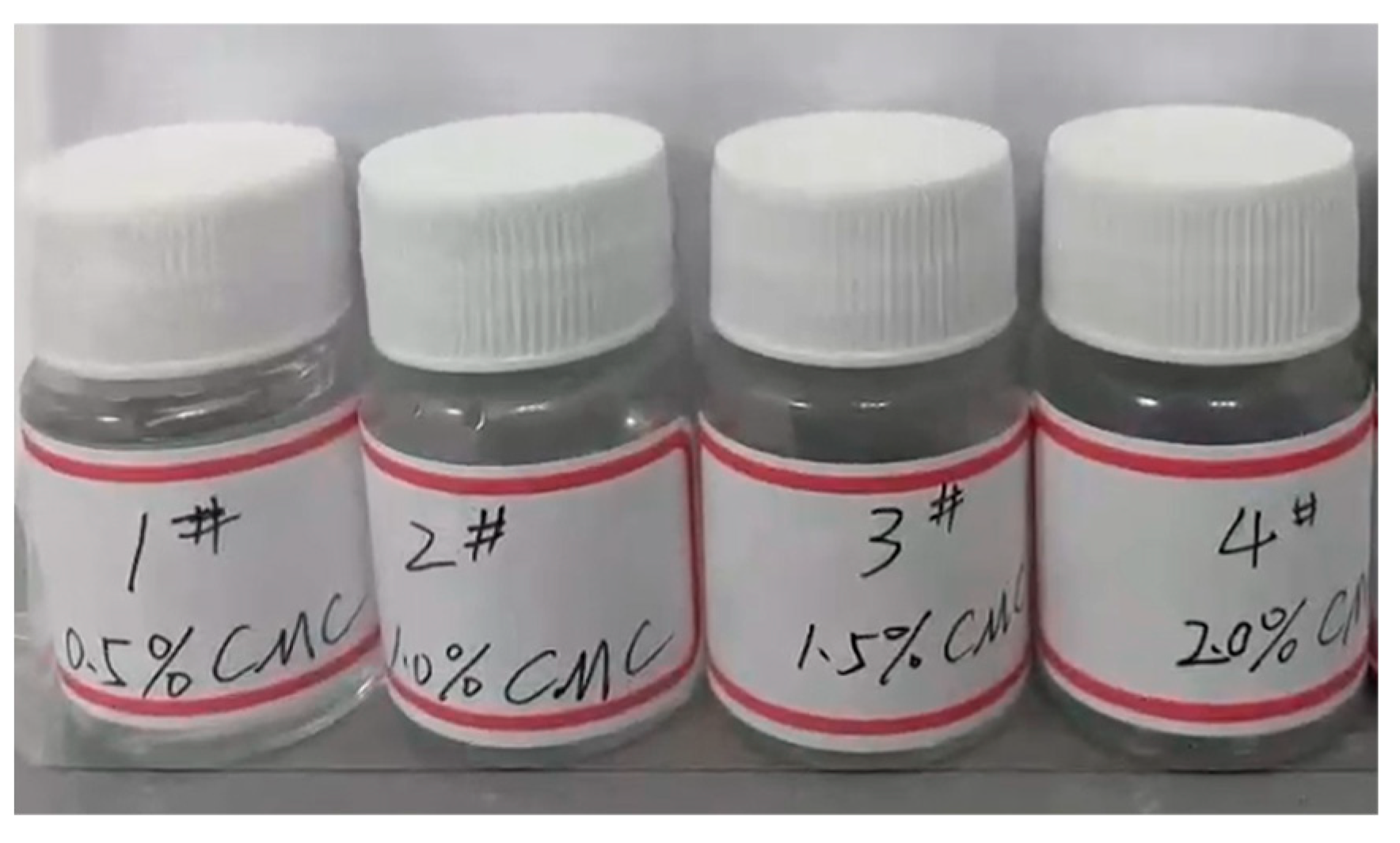

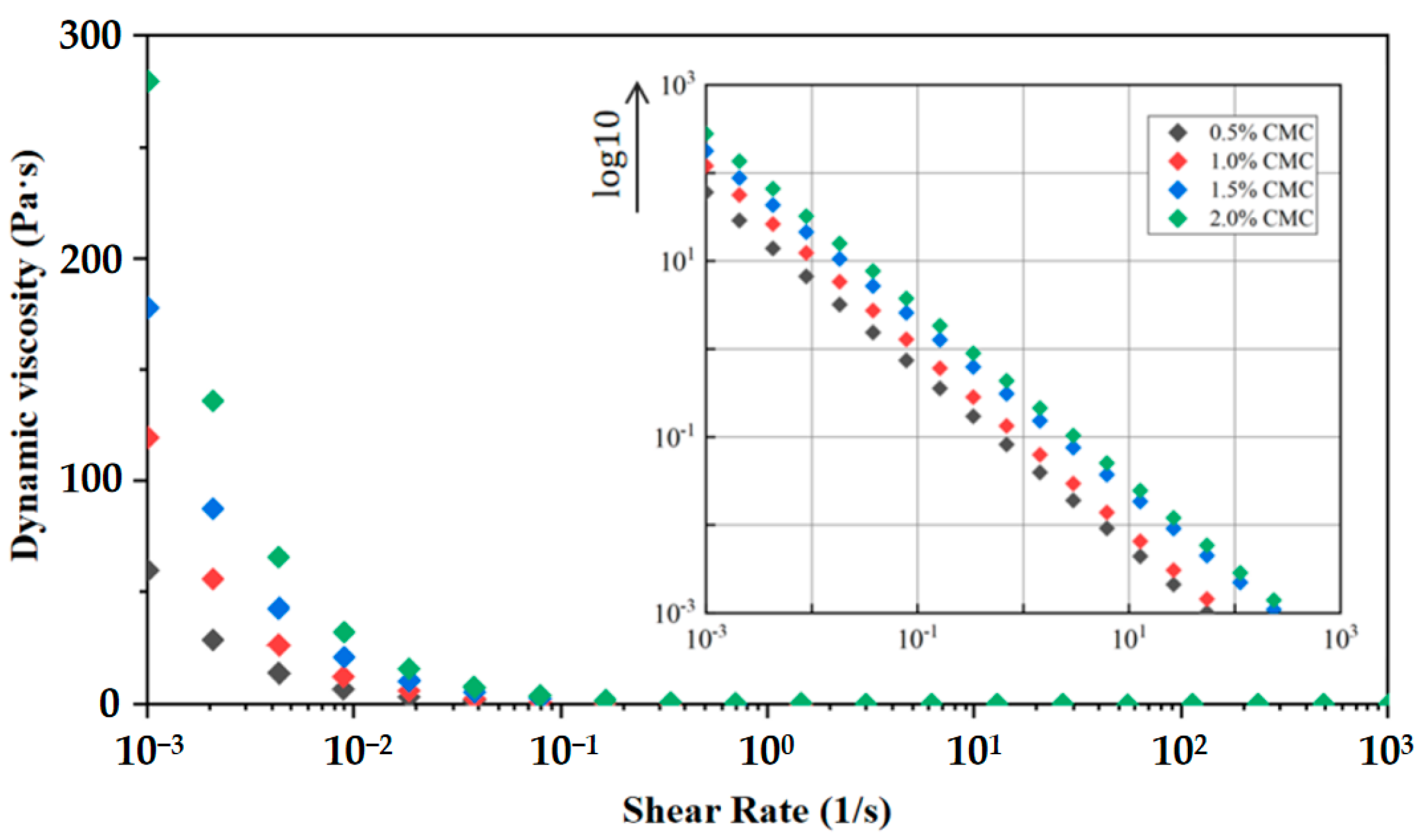

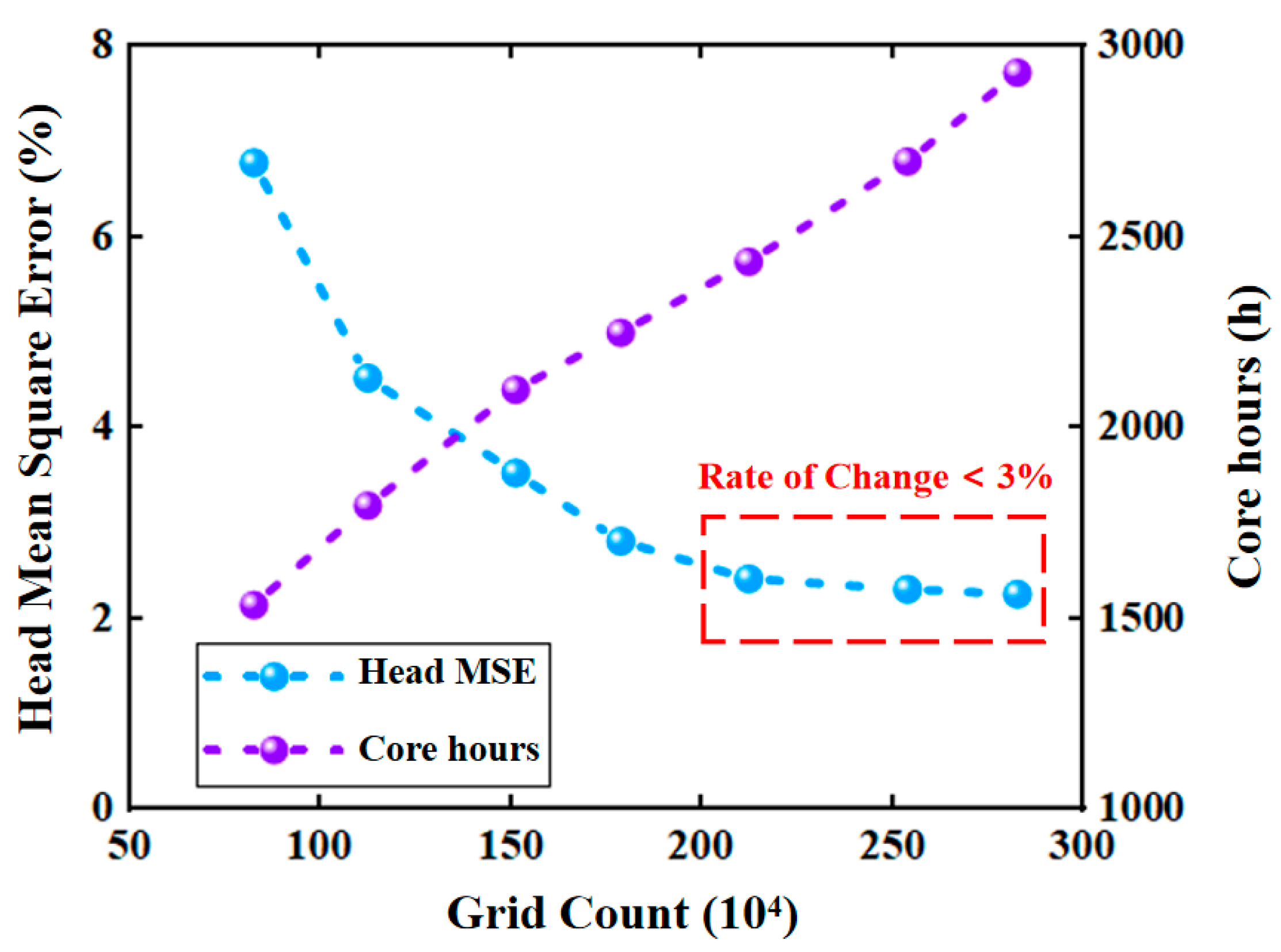

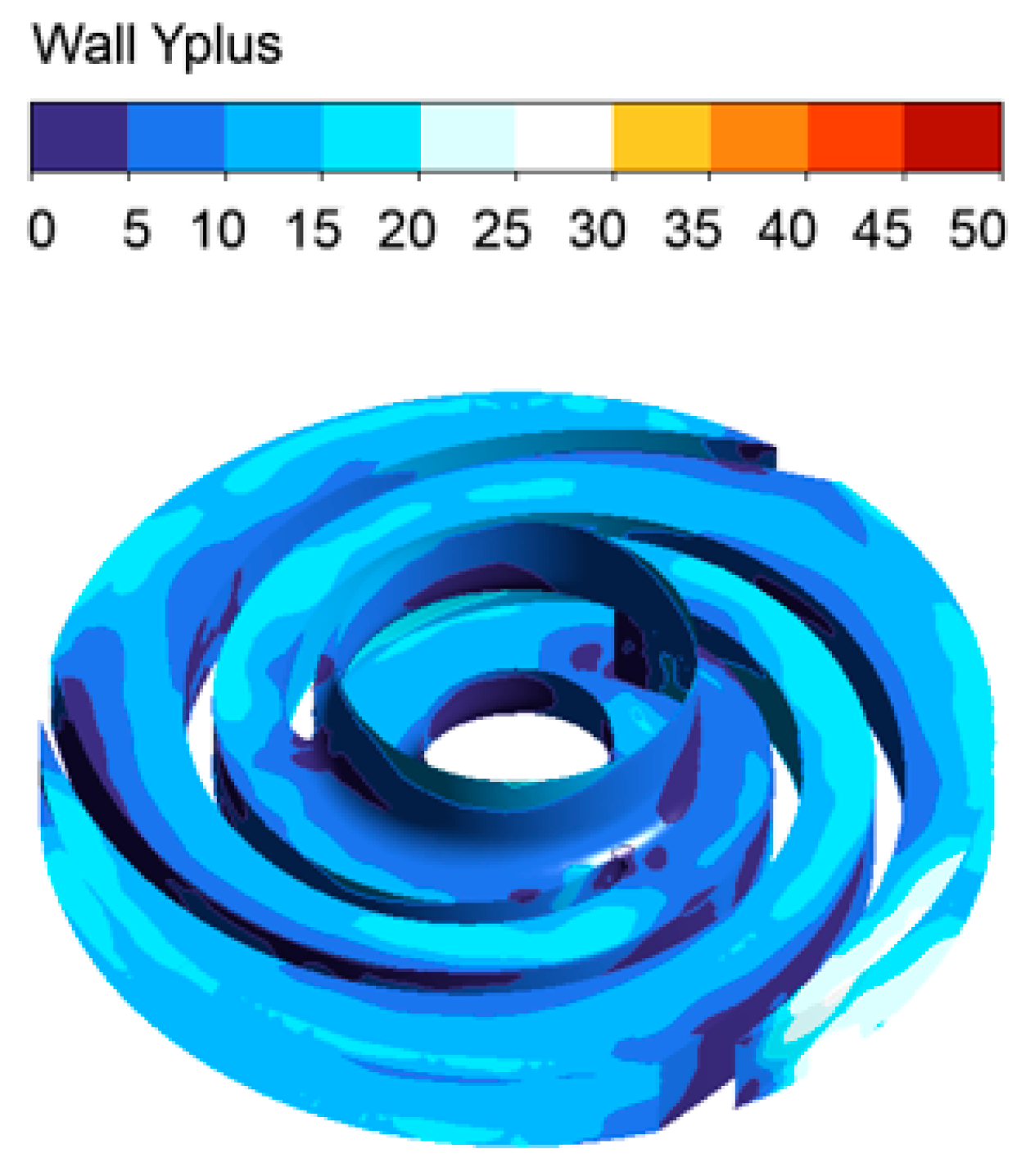
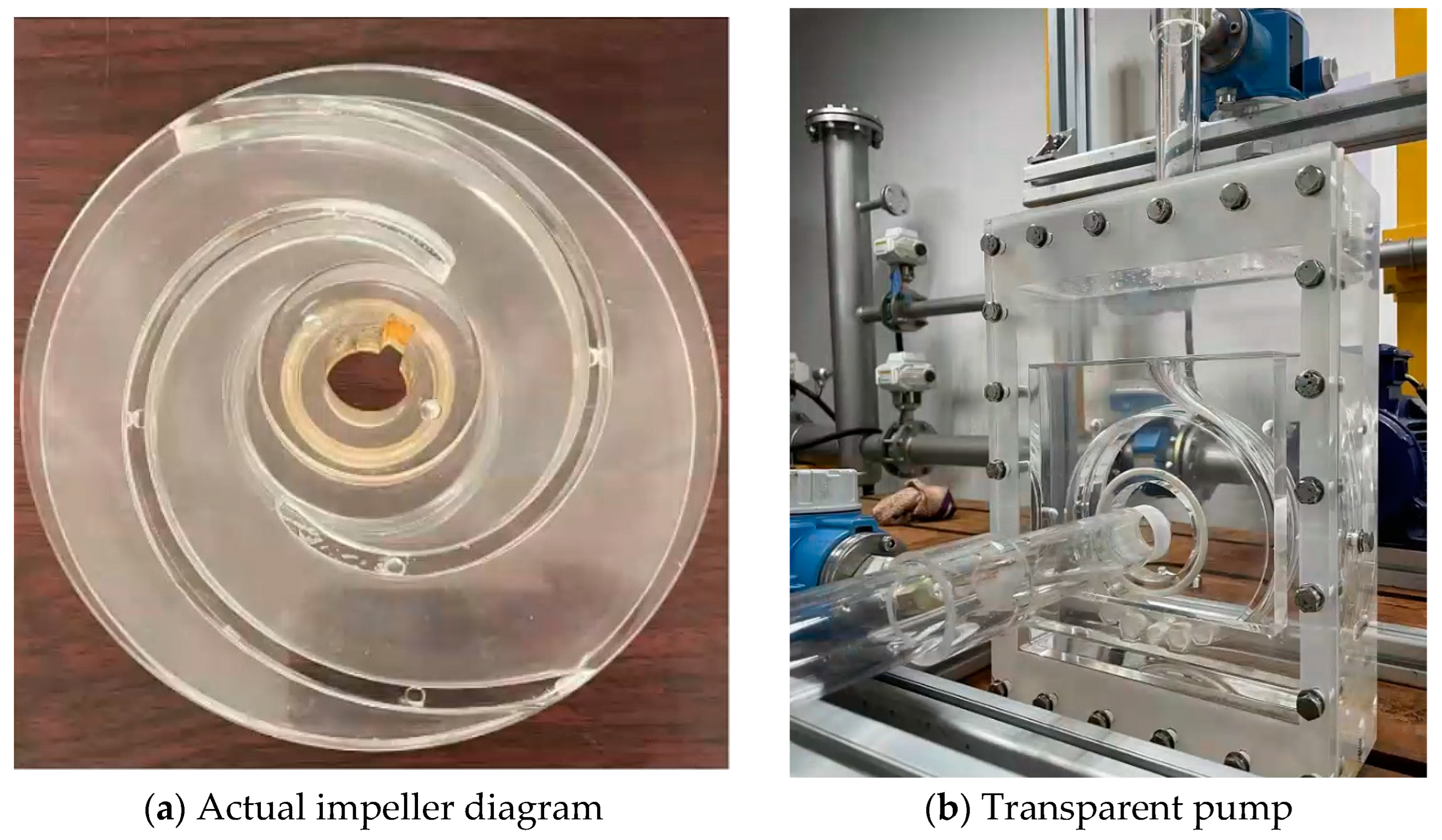
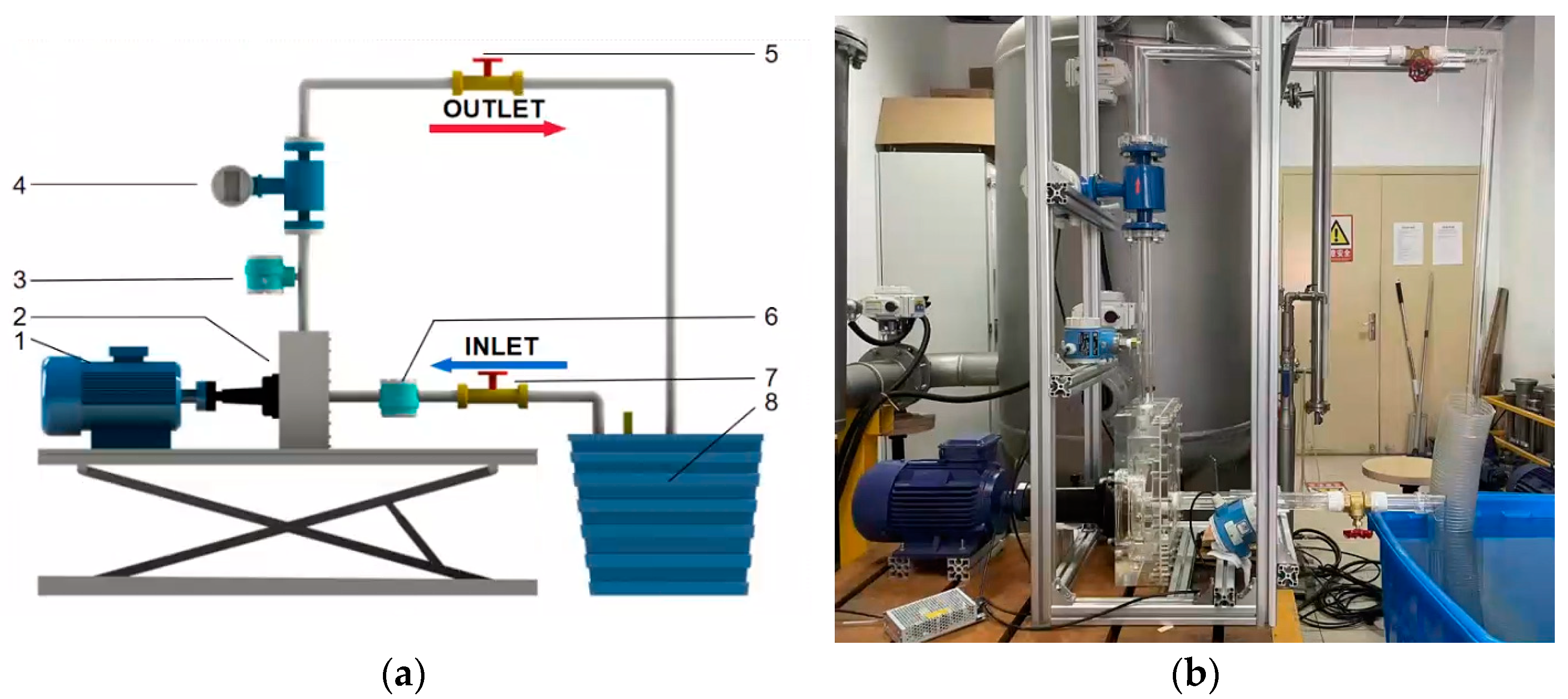





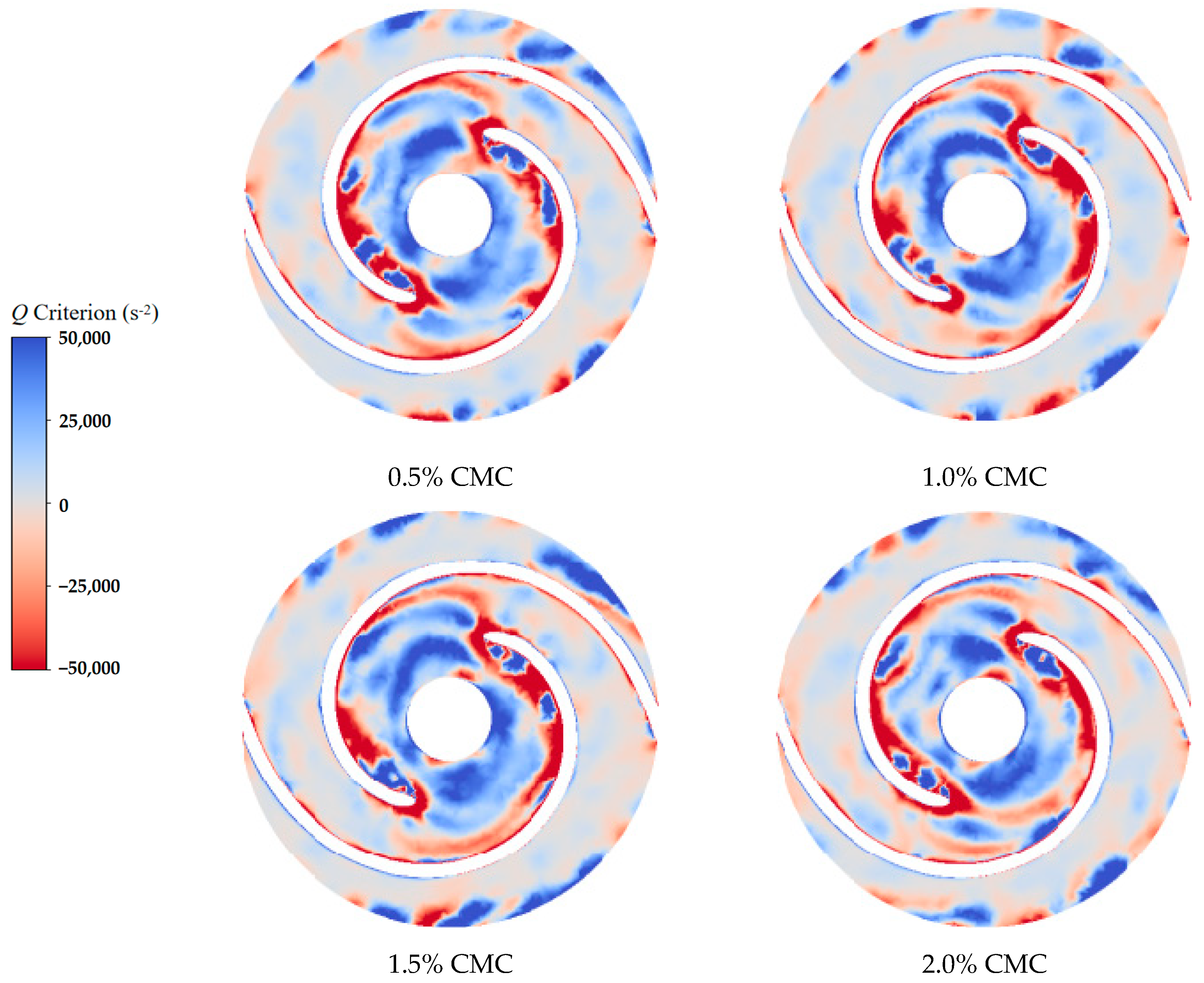
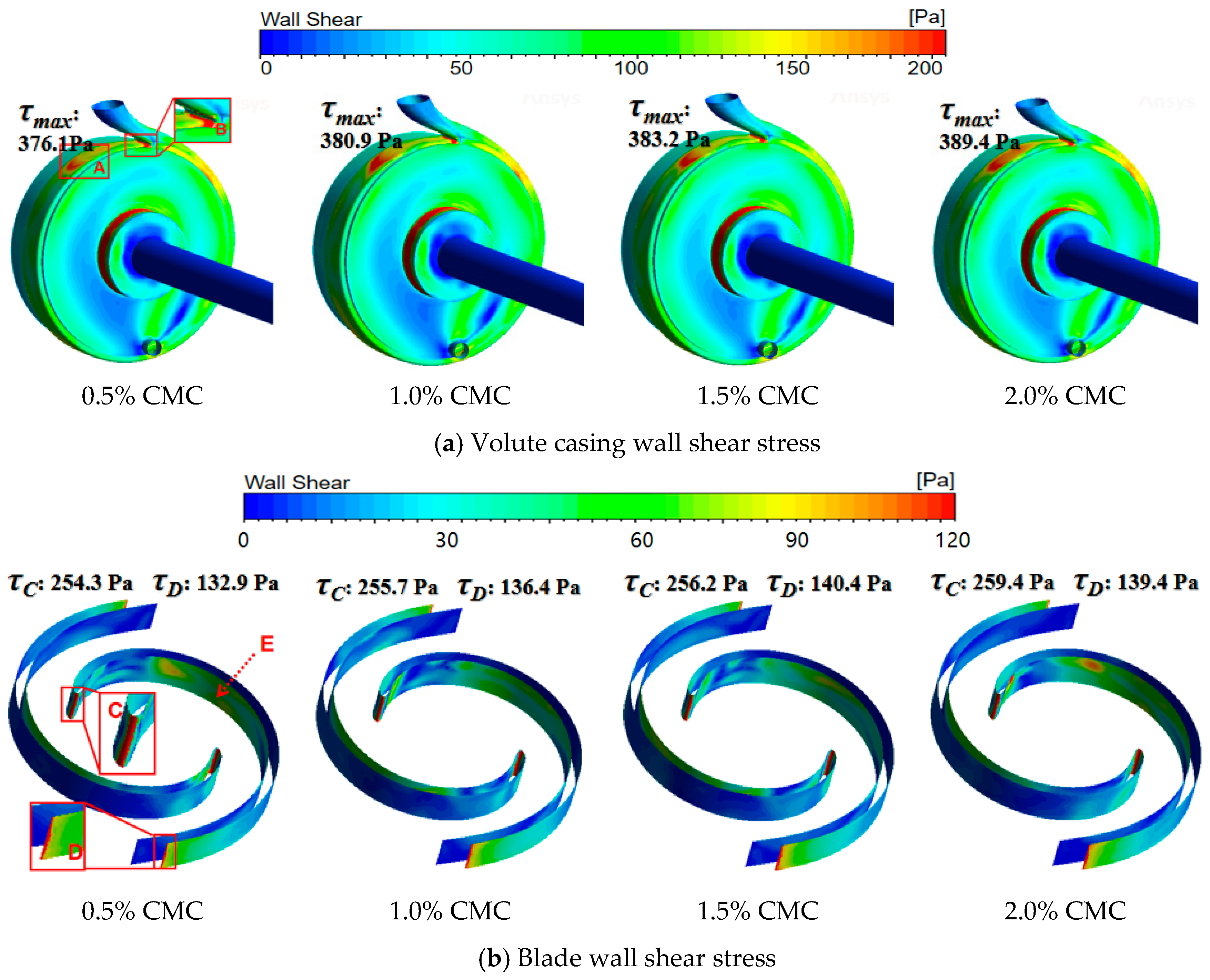
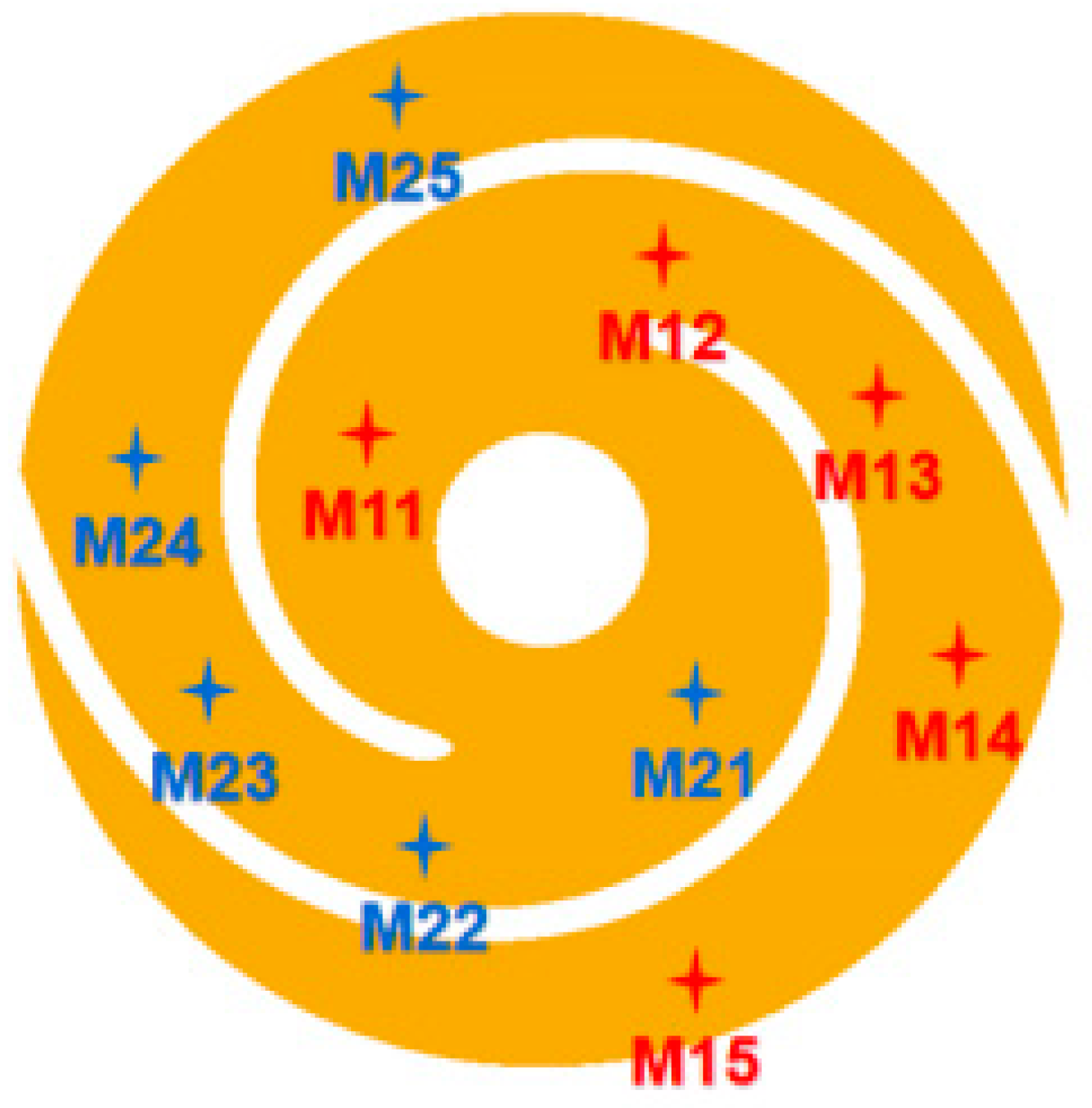
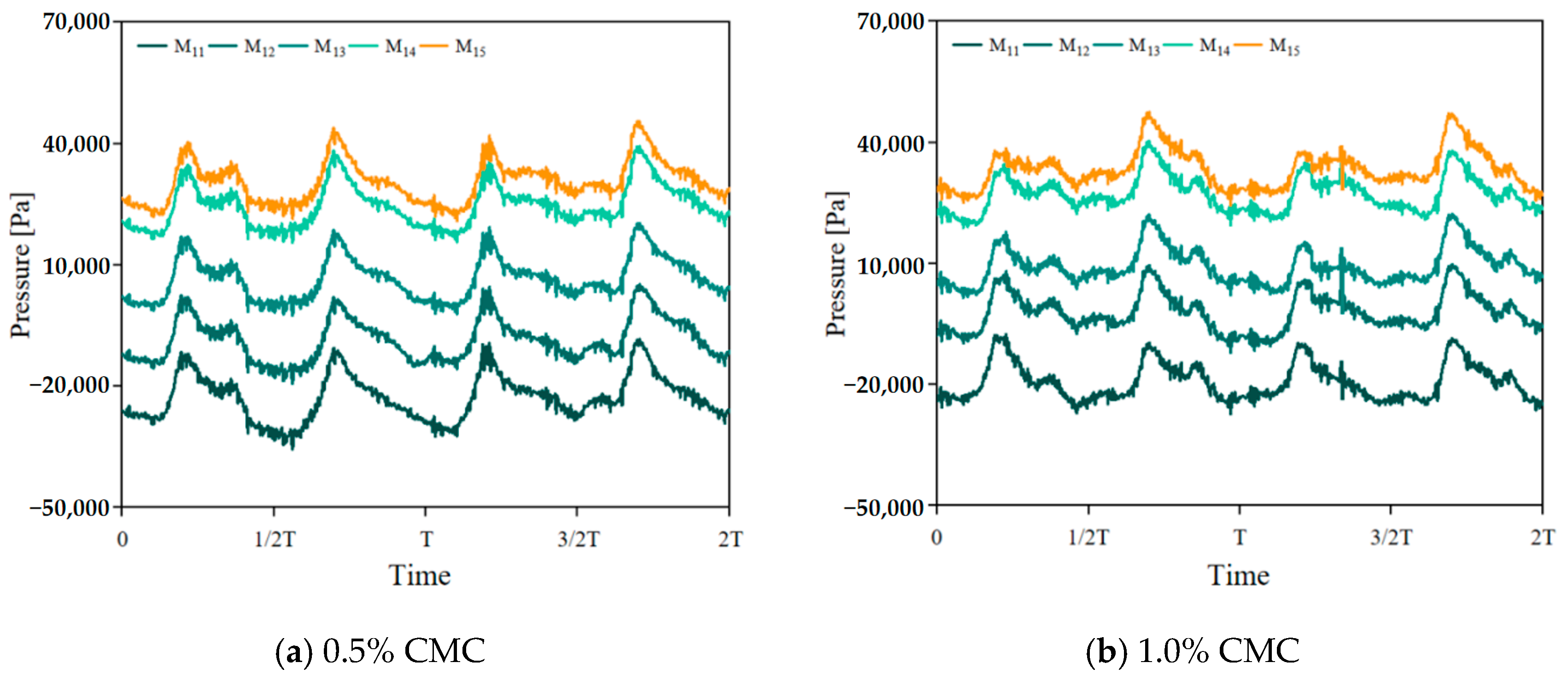
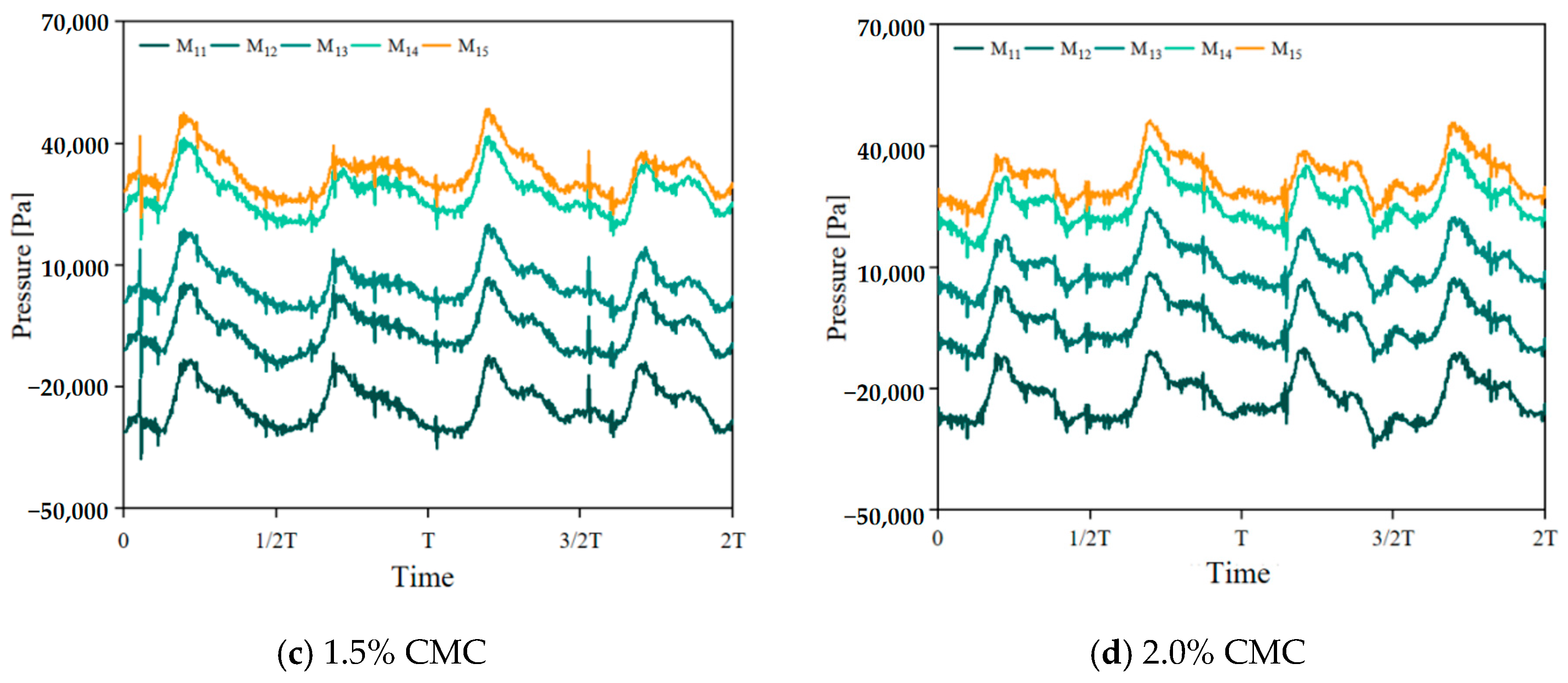
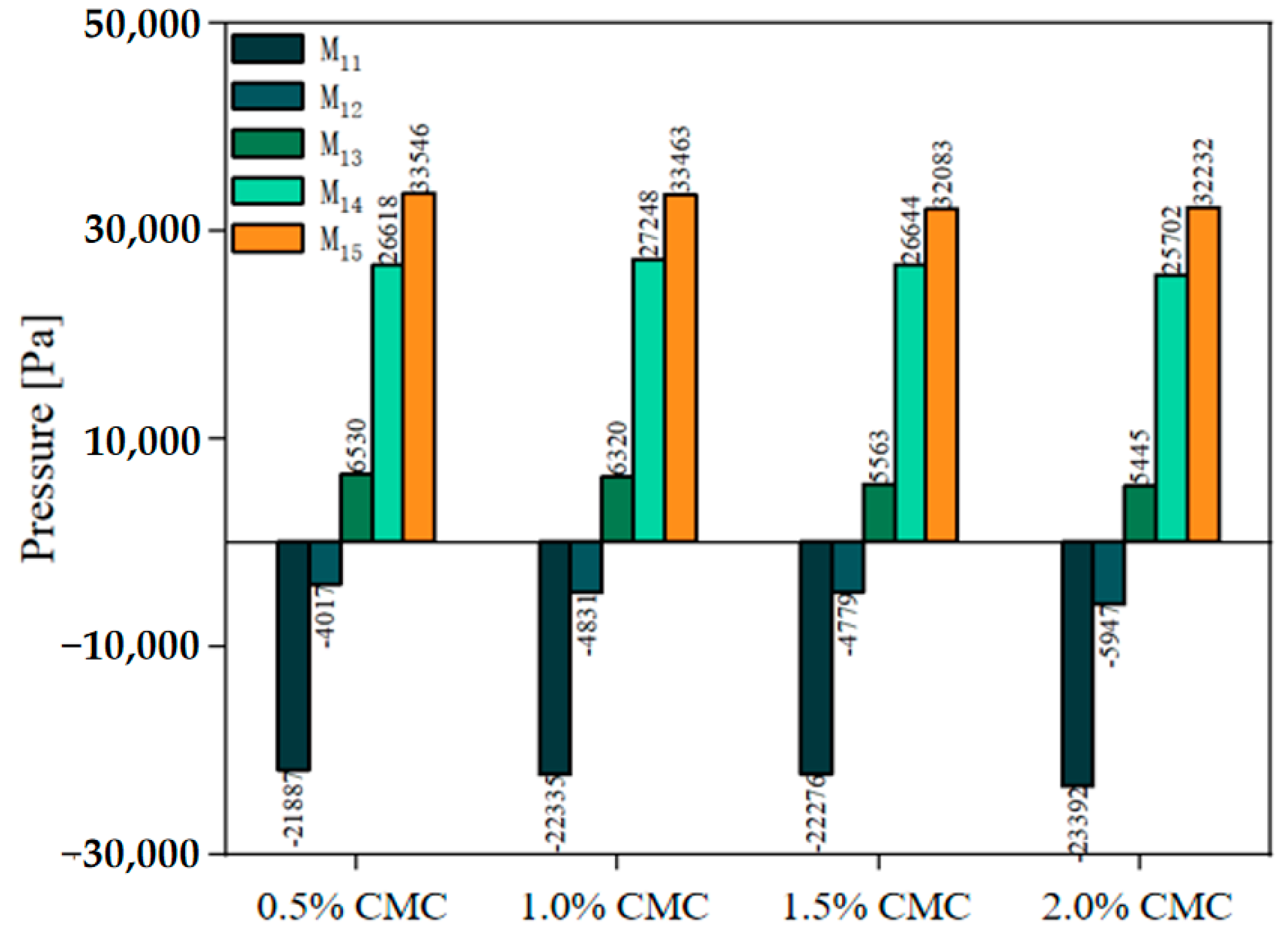
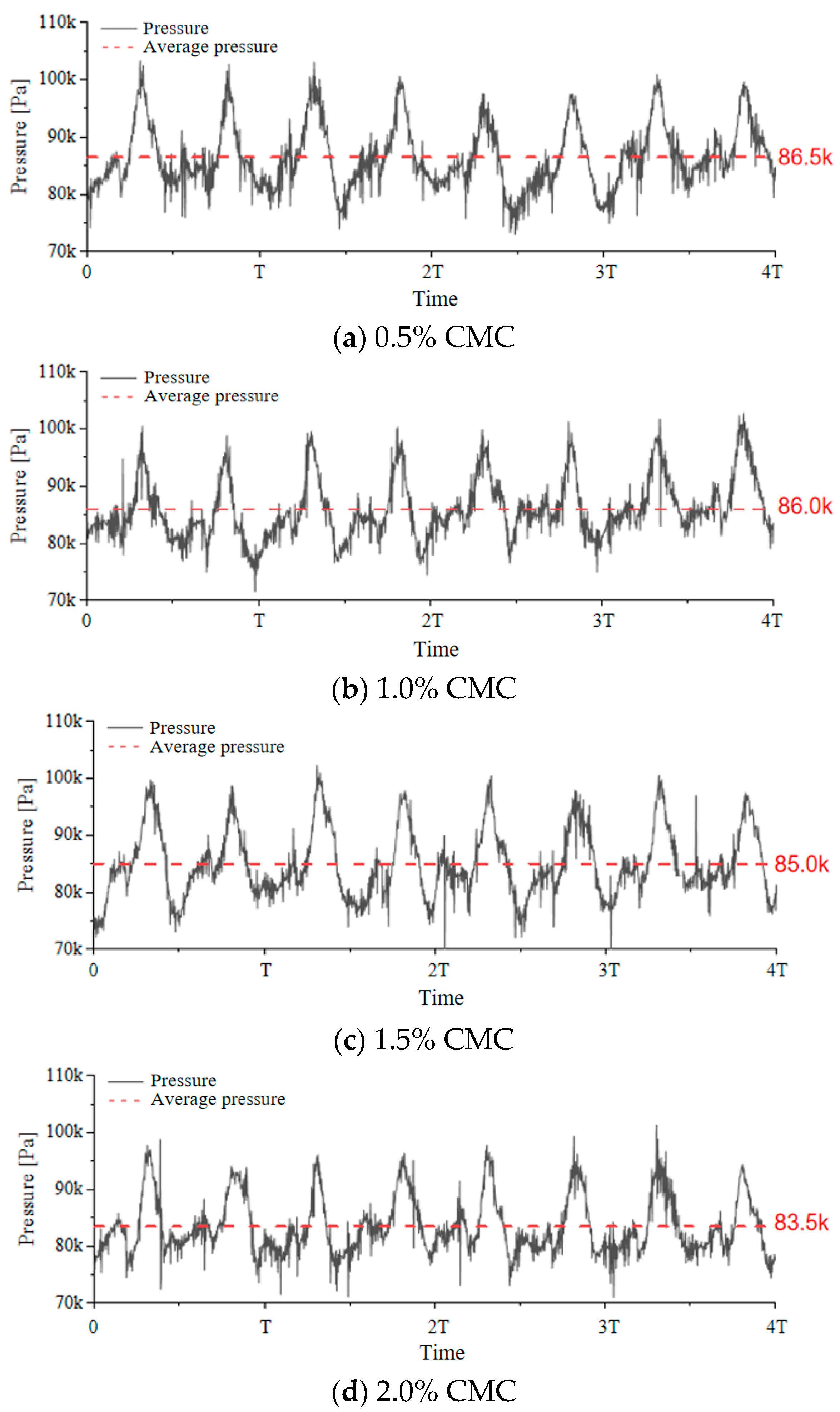
| Design Parameters | Numerical Value | Unit |
|---|---|---|
| Design Flow Rate | 6.5 | m3/h |
| Design Head | 7 | m |
| Rotation Speed | 1680 | r/min |
| Blade Number | 2 | |
| Impeller Inlet Diameter | 60 | mm |
| Impeller Outer Diameter | 158 | mm |
| Blade Outlet Width | 16 | mm |
| Blade Wrap Angle | 255 | ° |
| Computational Conditions | Settings |
|---|---|
| Inlet Boundary Condition | 6.5 [m3/h] |
| Outlet Boundary Condition | 101,325 [Pa] |
| Rotation Speed | 1680 [r/min] |
| Turbulence Modeling | the SST k-ω (Steady); the SAS (Transient) |
| Time Step Size | 9.921 × 10−5 [s] |
| Number of Time Steps | 5400 |
Disclaimer/Publisher’s Note: The statements, opinions and data contained in all publications are solely those of the individual author(s) and contributor(s) and not of MDPI and/or the editor(s). MDPI and/or the editor(s) disclaim responsibility for any injury to people or property resulting from any ideas, methods, instructions or products referred to in the content. |
© 2024 by the authors. Licensee MDPI, Basel, Switzerland. This article is an open access article distributed under the terms and conditions of the Creative Commons Attribution (CC BY) license (https://creativecommons.org/licenses/by/4.0/).
Share and Cite
Li, X.; Zheng, S.; Shao, Z.; Xu, M.; Li, Y.; Huang, Q.; Chai, M.; Sun, Z. Research on the Flow Characteristics of Power-Law Fluids in Self-Priming Sewage Pumps. Water 2024, 16, 1526. https://doi.org/10.3390/w16111526
Li X, Zheng S, Shao Z, Xu M, Li Y, Huang Q, Chai M, Sun Z. Research on the Flow Characteristics of Power-Law Fluids in Self-Priming Sewage Pumps. Water. 2024; 16(11):1526. https://doi.org/10.3390/w16111526
Chicago/Turabian StyleLi, Xukan, Shuihua Zheng, Zhenghao Shao, Mingjie Xu, Yiliang Li, Qing Huang, Min Chai, and Zenan Sun. 2024. "Research on the Flow Characteristics of Power-Law Fluids in Self-Priming Sewage Pumps" Water 16, no. 11: 1526. https://doi.org/10.3390/w16111526
APA StyleLi, X., Zheng, S., Shao, Z., Xu, M., Li, Y., Huang, Q., Chai, M., & Sun, Z. (2024). Research on the Flow Characteristics of Power-Law Fluids in Self-Priming Sewage Pumps. Water, 16(11), 1526. https://doi.org/10.3390/w16111526






